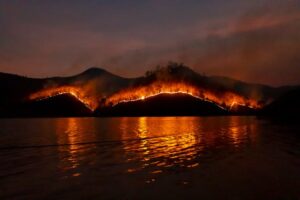Physical Address
23,24,25 & 26, 2nd Floor, Software Technology Park India, Opp: Garware Stadium,MIDC, Chikalthana, Aurangabad, Maharashtra – 431001 India
Physical Address
23,24,25 & 26, 2nd Floor, Software Technology Park India, Opp: Garware Stadium,MIDC, Chikalthana, Aurangabad, Maharashtra – 431001 India

By Aayushi Sharma
The 2023-24 has seen some of the most severe wildfire activity in recent history, with unprecedented fires reported across the globe, including record-breaking blazes in Canada, Greece, and the Amazon. The latest State of Wildfires report, published in the journal Earth System Science Data, sheds light on these alarming trends and their links to climate change.
The research team, which includes scientists from the UK and Brazil, found that climate change has dramatically increased the likelihood of such extreme fire events. Specifically, the probability of extreme fire seasons in Canada has risen by 2.9 to 3.6 times, while in the Amazon, it has surged by 20 to 28.5 times due to climate change.
Among the most notable events, the report stated, were the devastating wildfires in Canada, which set new records for both size and intensity. These fires contributed to a staggering 8.6 billion tonnes of carbon dioxide emissions globally, marking a 16 percent increase above the average. Emissions from Canadian wildfires alone were more than nine times the average of the past two decades and accounted for nearly a quarter of worldwide emissions.
The report, to be published annually now, is co-led by the University of East Anglia (UEA, UK), the UK Centre for Ecology & Hydrology (UKCEH), the Met Office (UK) and European Centre for Medium-Range Weather Forecasts (ECMWF, UK).
Role of climate change in wildfires: Key findings
The report indicates that climate change has heightened the likelihood of severe fire weather conditions, expanded long-term average burned areas, and intensified extreme burned areas for the 2023-24 period. In some regions, human activities, such as agriculture and forestry, have altered landscapes, affecting vegetation density and, in some cases, exacerbating fires, like in Western Amazonia.
In Canada, human influence was found to triple the chance of experiencing high fire weather in 2023. Particularly in the top 5% of the most burned areas, climate change caused fires to consume up to 40% more land than usual, although socioeconomic factors like population density and land-use changes likely reduced fire extent.
Similarly, in Greece, human influence increased the likelihood of severe fire weather in August 2023 by up to four times. The summer of 2023 saw the largest recorded wildfire in the country’s history. Climate change has amplified the average burned area over recent decades in the Mediterranean, though this has been somewhat counterbalanced by socioeconomic factors.
Dr. Francesca Di Giuseppe from the ECMWF commented that severe fire weather combined with abundant dry vegetation led to a significant rise in fire incidence and extent in Canada and Greece. However, human activities such as fire suppression and landscape fragmentation also played a crucial role in limiting the total burned areas.
In western Amazonia, climate change has almost certainly led to increased burned areas, with socioeconomic factors also likely contributing. Human influence has amplified the probability of experiencing high fire weather resulting in up to 50% more land burned than usual. In this region, the combined effects of climate change and land use changes have contributed to a general rise in burning.
The report highlights that severe fire weather conditions—characterized by high temperatures, low humidity, strong winds, and minimal precipitation—combined with ample dry vegetation have driven these intense wildfires. In Canada and Greece, human activities, including land use changes, have exacerbated the extent of these fires.
In the Amazon, agricultural expansion has further amplified fire vulnerability, leaving forests more susceptible to drought and fire weather conditions. This interplay between human activities and climate change underscores the need for comprehensive strategies to mitigate wildfire risks and adapt to the changing climate.
What are the future projections of the report?
Rising temperatures and shifting weather patterns have created drier conditions, diminishing the forest’s innate ability to withstand fires. This transformation in environmental dynamics presents significant hurdles in the management and containment of wildfires within these pristine ecosystems.
For the 2024 fire season, the State of Wildfire Report forecasts through August predict moderate positive anomalies (75th percentile) in fire weather for parts of Canada and much of South America, aligning with recent wildfire activity in these regions. A similar positive anomaly has been observed in Eastern Europe, particularly the Balkans. However, no significant global signals for extreme fire weather anomalies (95th percentile) are evident. The report also notes that while the El Niño phase is shifting to neutral in 2024, the positive phase of the Indian Ocean Dipole may continue to impact global fire patterns.
References:
https://essd.copernicus.org/articles/16/3601/2024/essd-16-3601-2024-discussion.html
5 ways in which Climate Change is affecting the Amazon Rainforest
Banner Image: https://www.pexels.com/photo/photo-of-wildfire-on-mountain-3552472/